The sweet, raw-onion and acrid wood-smoke smell of Africa rushed to greet me as I stepped off my plane in Livingstone. I was here to experience the famous Victoria Falls which was first discovered by explorer David Livingstone, a Scottish medical missionary, in 1855. But first, I had a date with an elephant.
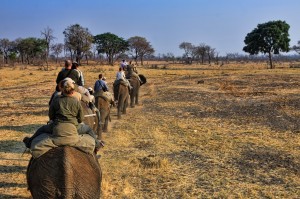 On arrival at the Elephant Camp for our elephant-back safari, the head guide provides insight into the lives of these gentle giants – Africa’s 4×4’s, as he jokingly refers to them. The head guide then runs through safety aspects and introduces the elephants and their handlers who all stand in line beside the platform from which visitors would mount. Some elephants had double or triple saddles strapped to their backs, depending on the size of the elephant. The front seat is reserved for the handler. My elephant was a big chap named Danny, “-but-“, assured my guide William, “-Clover is the one who really runs the place.” Upon mounting, the elephant-back safari begins and for the next hour our group took a gentle walk through riverine bush on the banks of the Zambezi River. Who would have guessed that the world’s largest animals could move about so silently? A dawn African elephant ride along the river banks of the Mosi-oi-Tunya’s National Park is an unforgettable experience – especially when you get to hand your elephant a few treats at the end. Elephants take visitors out twice a day for an hour-long walk and when not doing this are having fun at the river, just being elephants.
On arrival at the Elephant Camp for our elephant-back safari, the head guide provides insight into the lives of these gentle giants – Africa’s 4×4’s, as he jokingly refers to them. The head guide then runs through safety aspects and introduces the elephants and their handlers who all stand in line beside the platform from which visitors would mount. Some elephants had double or triple saddles strapped to their backs, depending on the size of the elephant. The front seat is reserved for the handler. My elephant was a big chap named Danny, “-but-“, assured my guide William, “-Clover is the one who really runs the place.” Upon mounting, the elephant-back safari begins and for the next hour our group took a gentle walk through riverine bush on the banks of the Zambezi River. Who would have guessed that the world’s largest animals could move about so silently? A dawn African elephant ride along the river banks of the Mosi-oi-Tunya’s National Park is an unforgettable experience – especially when you get to hand your elephant a few treats at the end. Elephants take visitors out twice a day for an hour-long walk and when not doing this are having fun at the river, just being elephants.
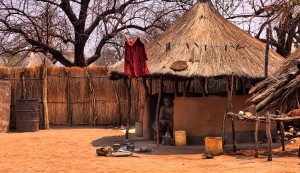 A five kilometer rib-shattering drive from Livingstone is Mukuni Village. Chief Siloka Mukuni is 70-years old and fluent in English. But today he did not avail himself to me. Instead he sent his village guide Felistus who took me on a village walk-about. Nothing is staged; this is true rural African village life, complete with schools and a clinic. I watched people in the act of creating food and young mothers with babies slung onto ready hips standing outside the dark mouths of their huts. Felistus claims the name of the village Mukuni means ‘big tree with big branches’. The chief’s palace is called Lumpasa which means ‘where the lion sleeps’. She points to a tall Acacia tree beneath which an old man sits huddled over the lion he’s carving from teak, deep lines etched on his face. Felistus claims this was where the villagers first encountered a white man. ‘Here’, says our guide, pointing to the Acacia tree, ‘is where David Livingstone waited to meet the village chief. But he was not granted an audience as the chief felt certain he was a ghost.’ She points out that every hut has an elephant grass head on its thatched pitch. When the husband dies the grass head is cut off. If the wife dies the direction of the door is changed because when her spirit returns she won’t be able to find the way in and will then be at peace and return to death. At the end of the half-hour tour I was taken back to my vehicle via the village craft market where I fought my way through throngs of curio carvers all trying to sell me something I couldn’t fit into my luggage.
A five kilometer rib-shattering drive from Livingstone is Mukuni Village. Chief Siloka Mukuni is 70-years old and fluent in English. But today he did not avail himself to me. Instead he sent his village guide Felistus who took me on a village walk-about. Nothing is staged; this is true rural African village life, complete with schools and a clinic. I watched people in the act of creating food and young mothers with babies slung onto ready hips standing outside the dark mouths of their huts. Felistus claims the name of the village Mukuni means ‘big tree with big branches’. The chief’s palace is called Lumpasa which means ‘where the lion sleeps’. She points to a tall Acacia tree beneath which an old man sits huddled over the lion he’s carving from teak, deep lines etched on his face. Felistus claims this was where the villagers first encountered a white man. ‘Here’, says our guide, pointing to the Acacia tree, ‘is where David Livingstone waited to meet the village chief. But he was not granted an audience as the chief felt certain he was a ghost.’ She points out that every hut has an elephant grass head on its thatched pitch. When the husband dies the grass head is cut off. If the wife dies the direction of the door is changed because when her spirit returns she won’t be able to find the way in and will then be at peace and return to death. At the end of the half-hour tour I was taken back to my vehicle via the village craft market where I fought my way through throngs of curio carvers all trying to sell me something I couldn’t fit into my luggage.
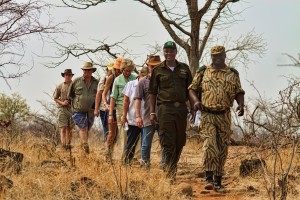
Our Livingstone Walking Safari guide, Mukwesa Kangwa, a tall camo-clad ebony faced man, introduced us to our suitably armed ‘Minister of Defense’/tracker – Clever Kamitondo, who would walk out front, scouting the the terrain ensuring our safe passage. The unbearable heat made the bush feel narrow, slender, barely hanging on. Everything was still. Kamitondo touched the paprika coloured soil then looked to the horizon, his eyes burned bright and sharp. “A herd of rhino had passed by here three days ago,” he said. He knew this as he had learnt the secrets of the bush at his father’s knee. He could smell where they had been and could see from the shift in the landscape where they had slept. We marched on through the crackling dry veldt, which looked like it may ignite, to the bush soundtrack of cicadas and the lone cry of an African Fish-Eagle. My ambitiously swollen backpack was getting heavier with each passing hour and I was itching with sweat. Kamitondo held his clenched fist up and we all fell in close behind him. He crouched down. Kamitondo and Kangwa spoke in low intense voices to each other in Shona; their words were like water over rocks, bubbling, soft, and incessant. We walked on in silence, increasing our pace. We rounded a clump of trees and there stood a rhino cow (and her calf). She stared us down. The upside-down V of her massive horn squatting on the end of her nose was every hunter’s desire. She sniffed the air and picked up our scent then, with an audible grunt, she raised her horn like a medieval weapon, then she and her baby were gone, plunging greyly into the bush.
A couple of guides from Lion Encounters and I headed off towards the river with three female lion cubs we’d walked there – Sadiki, Nuru and Ndulu (all under 9 months old). I watched them paddle and play in the water. Then got talking to the head guide about what happens to the lions when they get too big to walk with humans and all the talk about ‘canned hunting’ doing the rounds.terrain ensuring our safe passage. The unbearable heat made the bush feel narrow, slender, barely hanging on. Everything was still. Kamitondo touched the paprika coloured soil then looked to the horizon, his eyes burned bright and sharp, like the eyes of an old rooster. “A herd of rhino had passed by here three days ago,” he said. He knew this as he had learnt the secrets of the bush at his father’s knee. He could smell where they had been and could see from the shift in the landscape where 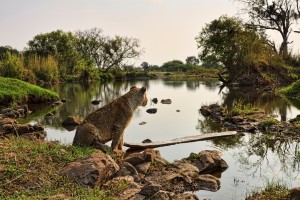 they had slept. We marched on through the crackling dry veldt, which looked like it may ignite, to the bush soundtrack of cicadas and the lone cry of an African Fish-Eagle. My ambitiously swollen backpack was getting heavier with each passing hour and I was itching with sweat. Kamitondo held his clenched fist up and we all fell in close behind him. He crouched down. Kamitondo and Kangwa spoke in low intense voices to each other in Shona; their words were like water over rocks, bubbling, soft, and incessant. We walked on in silence, increasing our pace. We rounded a clump of trees and there stood a rhino cow (and her calf). She stared us down. The upside-down V of her massive horn squatting on the end of her nose was every hunter’s desire. She sniffed the air and picked up our scent then, with an audible grunt, she raised her horn like a medieval weapon, then she and her baby were gone, plunging greyly into the bush.
they had slept. We marched on through the crackling dry veldt, which looked like it may ignite, to the bush soundtrack of cicadas and the lone cry of an African Fish-Eagle. My ambitiously swollen backpack was getting heavier with each passing hour and I was itching with sweat. Kamitondo held his clenched fist up and we all fell in close behind him. He crouched down. Kamitondo and Kangwa spoke in low intense voices to each other in Shona; their words were like water over rocks, bubbling, soft, and incessant. We walked on in silence, increasing our pace. We rounded a clump of trees and there stood a rhino cow (and her calf). She stared us down. The upside-down V of her massive horn squatting on the end of her nose was every hunter’s desire. She sniffed the air and picked up our scent then, with an audible grunt, she raised her horn like a medieval weapon, then she and her baby were gone, plunging greyly into the bush.
He explained that cubs of rescued lions as young as six weeks are taken for walks to allow them to build their confidence in the African bush which is where their natural hunting instincts develop which forms a necessary part of their release training. They are given the 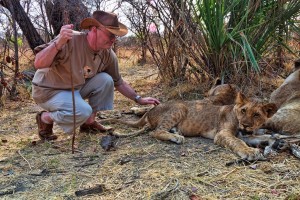 opportunity to develop a natural pride and social system in a 500 acre enclosure where they have plenty of game to hunt. They’ll remain at this stage until they are socially stable and self-sustaining. Then they’re released into a larger managed ecosystem where they’ll need to compete for food with species like hyena. This pride will give birth to cubs that will be raised in a wild environment within a natural pride social system but with zero human contact, making them truly wild lions. The cubs born to the rehabilitated lions will, once old enough, be released into the great African wilderness with all the skills and human avoidance behavior of any wild animal. It’s a seven- to eight-year programmed and currently has 140 lions in the system.
opportunity to develop a natural pride and social system in a 500 acre enclosure where they have plenty of game to hunt. They’ll remain at this stage until they are socially stable and self-sustaining. Then they’re released into a larger managed ecosystem where they’ll need to compete for food with species like hyena. This pride will give birth to cubs that will be raised in a wild environment within a natural pride social system but with zero human contact, making them truly wild lions. The cubs born to the rehabilitated lions will, once old enough, be released into the great African wilderness with all the skills and human avoidance behavior of any wild animal. It’s a seven- to eight-year programmed and currently has 140 lions in the system.
With no leashes, no collars, this is a once in a lifetime experience of walking with African lion cubs through the bush. And no, they’re not drugged or sold into canned hunting after they stop being cubs. It forms part of a conservation drive to repopulate the continent with lions whose numbers, in the past ten years, has dropped by eighty percent.
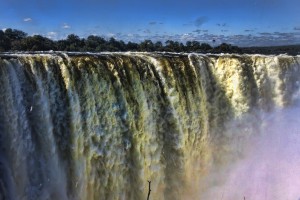 The 07h00 start to Livingstone Island on a ‘Morning Breezer’ excursion was a treat. A speedboat picked up Devils Pool candidates from the Royal Livingstone Hotel then sped across to Livingstone Island where guide, Alpha Omega, hurried us through the process of visiting the edge of the Victoria Falls cliff on foot. He then had us wade into the strong Zambezi current, swim across a small pool, climb over some jagged rocks (trainers would have been heaven-sent)
The 07h00 start to Livingstone Island on a ‘Morning Breezer’ excursion was a treat. A speedboat picked up Devils Pool candidates from the Royal Livingstone Hotel then sped across to Livingstone Island where guide, Alpha Omega, hurried us through the process of visiting the edge of the Victoria Falls cliff on foot. He then had us wade into the strong Zambezi current, swim across a small pool, climb over some jagged rocks (trainers would have been heaven-sent)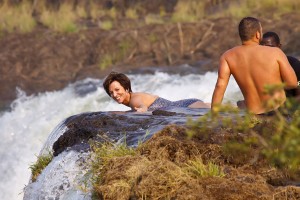 then dive into another pool which leads to the last ledge before tumbling down into the Victoria Falls. Each adrenaline junkie was in turn maneuvered to the edge where Alpha Omega held onto our ankles, giving us the opportunity to lean over. This provided a good few opportunities for ‘selfies’. Followed by a pretty amazing bush breakfast fellow Devils Pool survivors decided this experience should be at the top of
then dive into another pool which leads to the last ledge before tumbling down into the Victoria Falls. Each adrenaline junkie was in turn maneuvered to the edge where Alpha Omega held onto our ankles, giving us the opportunity to lean over. This provided a good few opportunities for ‘selfies’. Followed by a pretty amazing bush breakfast fellow Devils Pool survivors decided this experience should be at the top of 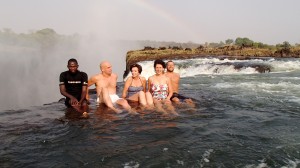 everyone’s bucket-list.
everyone’s bucket-list.
Livingstone’s town center has a lively nightlife and is packed with good eateries like The Kubu Cafe. Due to a large 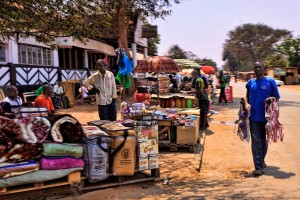 Indian population there are numerous good curry houses too; try the Ocean Basket for fish. Here I took myself off to one side to take in the night sky with its frozen stars and a cloud that draped the face of the moon like a wedding veil. I caught wisps of conversation from the dining table. I studied the dramatics of the UN-like gathering of nations who were here to chat and talk about their day. I came to the quiet conclusion that this is how Zambia should be experienced; David Livingstone would have liked that.
Indian population there are numerous good curry houses too; try the Ocean Basket for fish. Here I took myself off to one side to take in the night sky with its frozen stars and a cloud that draped the face of the moon like a wedding veil. I caught wisps of conversation from the dining table. I studied the dramatics of the UN-like gathering of nations who were here to chat and talk about their day. I came to the quiet conclusion that this is how Zambia should be experienced; David Livingstone would have liked that.
DID YOU KNOW
• Zambia is slightly larger than Texas with a population of just shy of 13-million (despite this, the entire country’s telephone directory is less than an inch thick).
• Internationally acclaimed author, Wilbur Smith, was born in Zambia.
• From November to April Zambia experiences rainstorms on par with the Asian monsoon.
• Zambia has a white Vice President – which is an occurrence is Africa.
• A mushroom native to Zambia grows nearly a yard in diameter; making it the world’s largest.
• Livingstone was Zambia’s first capital.
• Zambia is one of the world’s poorest countries (85% of the population live below the poverty line) and is one of the hardest hit with HIV/AIDS.
• It has seven semi-official languages.
• Until 1964 Zambia was known as Northern Rhodesia and celebrates its Independence Day on October 24.
• Nshima (ground cornmeal) is the country’s staple food.
• Zambia is the worlds’ fifth largest producer of copper.

